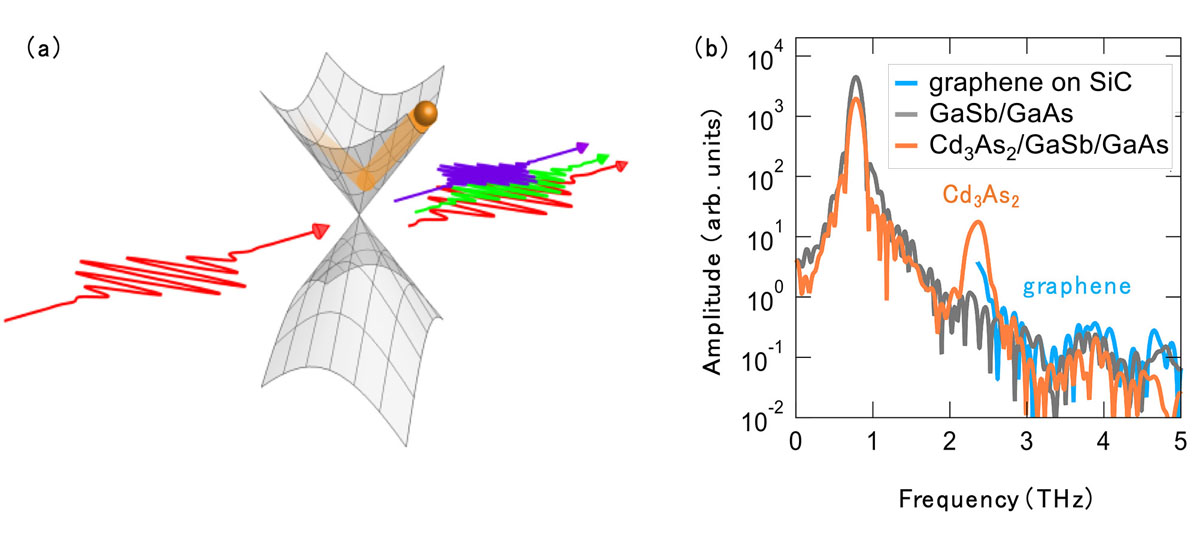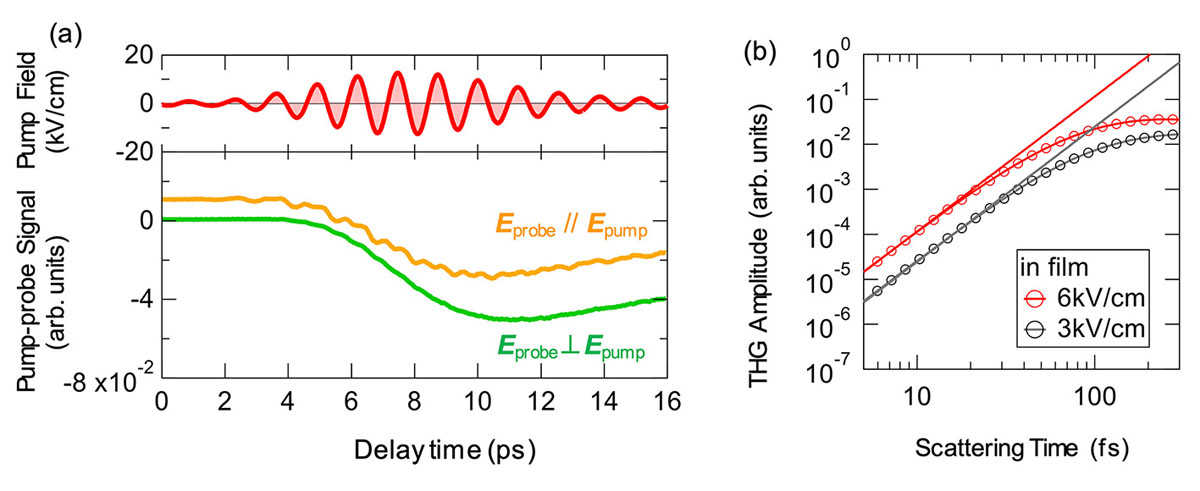Efficient Terahertz Harmonic Generation with Coherent Acceleration of Electrons in the Dirac Semimetal Cd3As2
Matsunaga, Tsunetsugu, and Itatani Groups
Intense waveform-controlled light field has revealed highly-intriguing nonlinear and nonperturbative light-matter interactions such as high-order harmonic generation (HHG). Recently, HHG in solids with mid-infrared (IR) excitation has been reported, opening a new route toward laser-based stable and compact extreme ultraviolet (EUV) sources. Meanwhile, in the long wavelength limit, efficient third harmonic generation (THG) in the terahertz (THz) frequency regime has also been reported in a superconducting film [1]. Realization of such extreme nonlinear photonics in the THz region at room temperature is highly desired for high-speed THz electronics and for nonlinear frequency mixing in sensitive detection of cosmic microwave background. From these perspectives, graphene has attracted tremendous attention as a candidate for efficient THz frequency multiplication using massless Dirac electrons because the current flow across the Dirac node in the momentum space is expected to exhibit remarkably large nonlinearity [2], as schematically shown in Fig. 1(a). Very recently, HHG in the THz frequency range in graphene was clearly demonstrated by using a very intense light source that is based on a large-scale electron accelerator [3]. In their experiment, the nonlinear coefficients in graphene were found to be much larger than typical materials, whereas the conversion efficiency is still limited by its monolayer nature.
In our work [4], we investigated THz nonlinear spectroscopy for thin films (thickness of 240 nm) of the three-dimensional Dirac semimetal Cd3As2 at room temperature using a laboratory-scale laser source. We have observed intense THz pulse generation using this laser-based setup and performed nonlinear transmission spectroscopy of quasi-monochromatic intense THz pulse with the center frequency of 0.8 THz [4]. Figure 1(b) shows the results of the spectral amplitude for transmitted pulses. A sharp peak of THG is clearly observed at 2.4 THz, which demonstrates the efficient nonlinear frequency conversion of the THz light. For comparison, we examined monolayer graphene with the same excitation condition, and also observed the THG signal. The nonlinear coefficient for graphene was estimated as ~10-9 m2V-2, which is consistent with the previous literature, and several orders of magnitude larger than typical materials. Compared to graphene, the conversion efficiency in Cd3As2 is much larger due to the film thickness, and the observed THG field amplitude is ~100 V/cm under the pump field of 6.5 kV/cm inside the film. In the next step, we can reduce the Fresnel reflection loss at the sample surface by using an antireflection coating on the film or directly applying the field via contact electrodes, which will allow to generate further stronger harmonics for realistic applications in ultrafast electronics.
To understand the efficient HHG mechanism in Cd3As2 in a microscopic picture, we also performed THz pump-THz probe spectroscopy. In the case of graphene, the origin of the THz HHG was successfully explained by a thermodynamic model where electrons were assumed to be in quasi-equilibrium with repeating heating and cooling processes very rapidly within the THz timescale [3]. However, such a picture of incoherent electron dynamics is essentially different from the originally proposed scheme to induce large nonlinearity in massless Dirac systems [2]. Our time-resolved THz spectroscopy in this work has revealed that the relaxation rate of the carriers in Cd3As2 is ~8 ps, which is much longer than one optical cycle of the pump field (1.25 ps) in contrast to the rapid cooling in graphene (<< 1 ps). We performed the thermodynamic-model calculation and confirmed that this model cannot reproduce the efficient THG with realistic parameters.
In addition, we experimentally investigated the electron dynamics during the THz wave irradiation and found that the nonlinear response manifests itself almost only for the pump polarization direction, as shown in Fig. 2(a). The result can be well explained by the intraband current model [2]. When electrons are accelerated by the pump field, the electron distribution function in the momentum space moves rapidly back and forth along with the pump polarization direction, but it appears as if “nothing happens” in other probe polarization directions, which was observed as the anisotropic nonlinearity. We also calculated the nonlinear current by considering the intraband acceleration in a simple linear dispersion model and confirmed that the intraband acceleration model can reproduce the value of the THG amplitude and its saturating behavior which we observed.
Our results show that, even though the scattering time of ~145 fs in Cd3As2 is still shorter than the pump field cycle of 1.25 ps, the nonlinear response is well described by the intraband current by coherent acceleration of electrons. It can be explained by the fact that asymmetric non-thermal electron population distribution in momentum space can be developed as rapidly as in ~85 fs. Figure 2(b) shows the calculated result of the THG amplitude as a function of the scattering time. If the scattering time is as long as 100 fs, the THG amplitude strongly saturates. Therefore, the scattering time of 145 fs in this material is “long enough” for nonperturbative intraband acceleration driven by the optical field of a few-kV/cm.
In future, even longer scattering times might be achieved in other topological semimetals with massless dispersion, which will allow us more efficient frequency conversion, perhaps at sub-kV/cm field strength. Our results will open a new pathway towards a novel frequency convertor in the THz frequency based on Dirac semimetals.
References
- [1] R. Matsunaga et al., Science 345, 1145 (2014).
- [2] S. A. Mikhailov, Europhys. Lett. (EPL) 79, 27002 (2007).
- [3] H. A. Hafez et al., Nature 561, 507 (2018).
- [4] B. Cheng†, N. Kanda†, T. N. Ikeda, T. Matsuda, P. Xia, T. Schumann, S. Stemmer, J. Itatani, N. P. Armitage, and R. Matsunaga, Phys. Rev. Lett. 124, 117402 (2020). (†: equal contribution)


